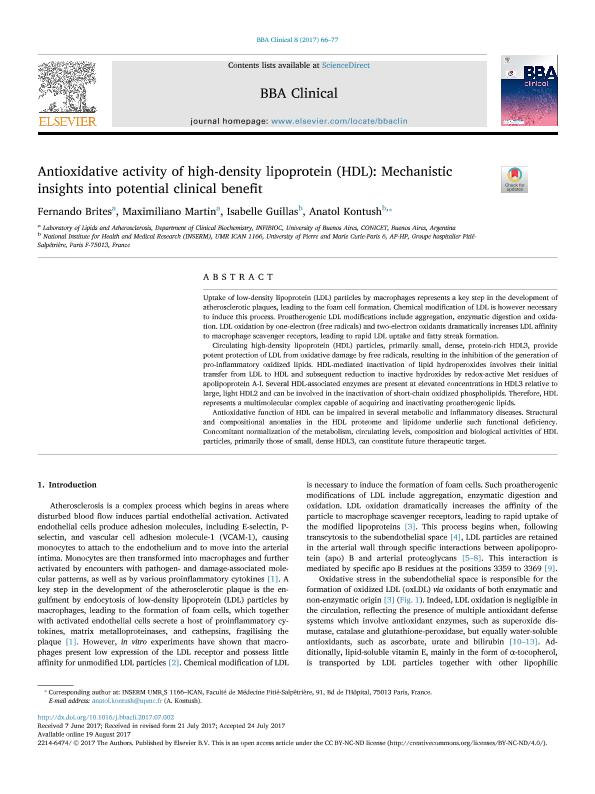Artículo
Antioxidative activity of high-density lipoprotein (HDL): Mechanistic insights into potential clinical benefit
Fecha de publicación:
19/12/2017
Editorial:
Elsevier
Revista:
BBA Clinical
ISSN:
2214-6474
Idioma:
Inglés
Tipo de recurso:
Artículo publicado
Clasificación temática:
Resumen
Uptake of low-density lipoprotein (LDL) particles by macrophages represents a key step in the development of atherosclerotic plaques, leading to the foam cell formation. Chemical modification of LDL is however necessary to induce this process. Proatherogenic LDL modifications include aggregation, enzymatic digestion and oxidation. LDL oxidation by one-electron (free radicals) and two-electron oxidants dramatically increases LDL affinity to macrophage scavenger receptors, leading to rapid LDL uptake and fatty streak formation. Circulating high-density lipoprotein (HDL) particles, primarily small, dense, protein-rich HDL3, provide potent protection of LDL from oxidative damage by free radicals, resulting in the inhibition of the generation of pro-inflammatory oxidized lipids. HDL-mediated inactivation of lipid hydroperoxides involves their initial transfer from LDL to HDL and subsequent reduction to inactive hydroxides by redox-active Met residues of apolipoprotein A-I. Several HDL-associated enzymes are present at elevated concentrations in HDL3 relative to large, light HDL2 and can be involved in the inactivation of short-chain oxidized phospholipids. Therefore, HDL represents a multimolecular complex capable of acquiring and inactivating proatherogenic lipids. Antioxidative function of HDL can be impaired in several metabolic and inflammatory diseases. Structural and compositional anomalies in the HDL proteome and lipidome underlie such functional deficiency. Concomitant normalization of the metabolism, circulating levels, composition and biological activities of HDL particles, primarily those of small, dense HDL3, can constitute future therapeutic target.
Palabras clave:
Hdl
Archivos asociados
Licencia
Identificadores
Colecciones
Articulos(OCA HOUSSAY)
Articulos de OFICINA DE COORDINACION ADMINISTRATIVA HOUSSAY
Articulos de OFICINA DE COORDINACION ADMINISTRATIVA HOUSSAY
Citación
Brites, Fernando Daniel; Martin, Maximiliano Emanuel; Guillas, Isabelle; Kontush, Anatol; Antioxidative activity of high-density lipoprotein (HDL): Mechanistic insights into potential clinical benefit; Elsevier; BBA Clinical; 8; 19-12-2017; 66-77
Compartir
Altmétricas




